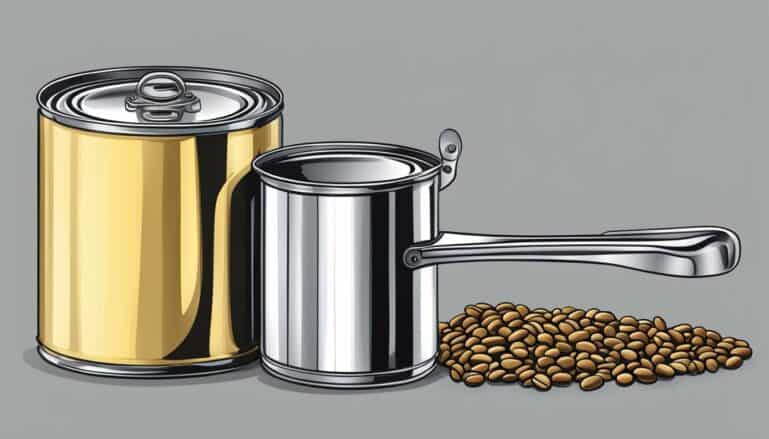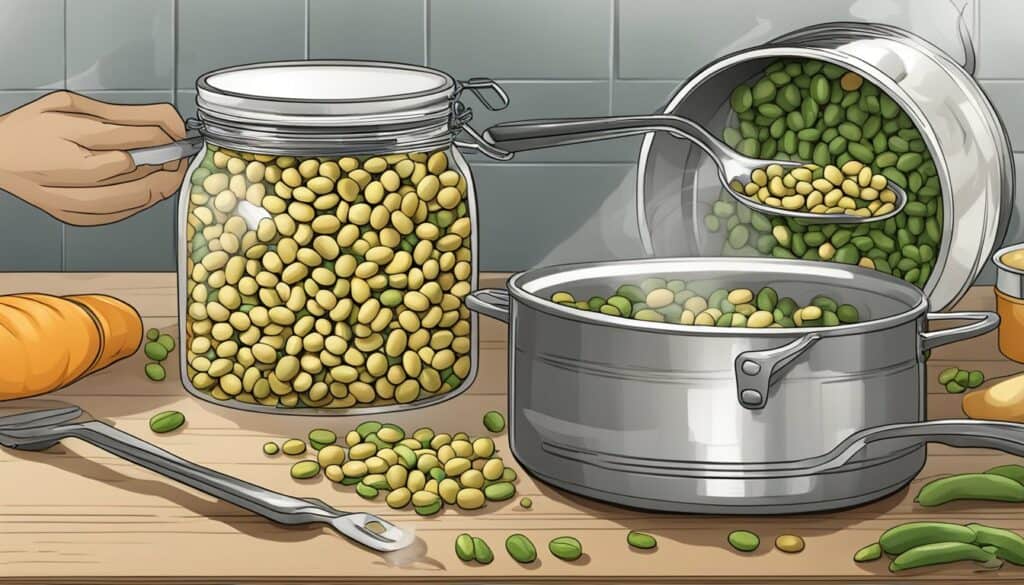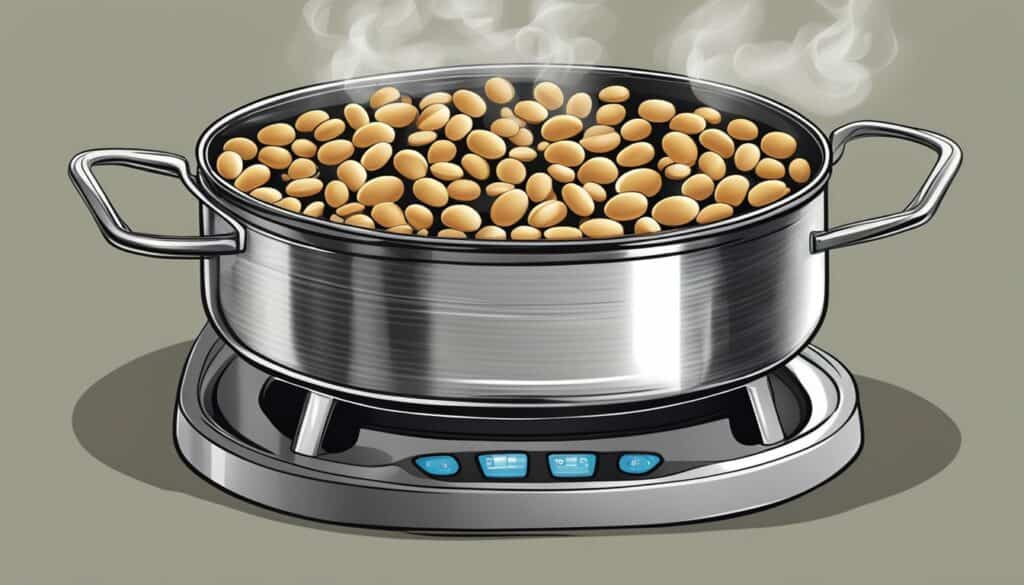How to Cook Canned Beans: A Simple and Foolproof Guide

Table of Contents
Understanding Canned Beans
As someone who loves to cook, canned beans are a staple in my pantry. They are a convenient and inexpensive source of protein and fiber, and can be used in a variety of dishes. Here are a few things to keep in mind when using canned beans:
-
Types of beans: There are many types of canned beans available, including black beans, kidney beans, pinto beans, cannellini beans, lima beans, and great northern beans. Each type has a slightly different flavor and texture, so experiment to find your favorites.
-
Nutritious: Canned beans are a great source of protein, fiber, and other nutrients. They are a healthy addition to any meal.
-
Convenience: Canned beans are incredibly convenient. They are already cooked, so all you need to do is heat them up. They are perfect for busy weeknights when you don’t have a lot of time to cook.
-
Storage: Canned beans can be stored in your pantry for months. Once opened, they can be stored in the refrigerator for up to a week. If you have leftovers, they can be frozen for up to six months.
Overall, canned beans are a great ingredient to have on hand. They are nutritious, convenient, and versatile. Plus, they are an inexpensive way to add protein and fiber to your diet.
Preparing for Cooking
Before cooking canned beans, there are a few important steps you should take to ensure the best results.
Drain and Rinse
First, drain the liquid from the can and rinse the beans thoroughly with cold water. This helps to remove any excess salt and starch, as well as improve their texture.
Soaking
If you are using dried beans instead of canned, it is important to soak them overnight before cooking. Soaking helps to soften the beans and reduce cooking time. Simply place the beans in a large bowl, cover with water, and let sit overnight.
Washing
In addition to rinsing canned beans, it is also a good idea to wash them before cooking. This helps to remove any remaining dirt or debris that may be present.
Choosing the Right Beans
When selecting canned beans, consider the type of bean you want to use. Black beans, kidney beans, and pinto beans are all popular options. Each type has its own unique flavor and texture, so choose the one that best suits your recipe.
By following these simple steps, you can prepare your canned beans for cooking and ensure they turn out perfectly every time.

Cooking Methods
When it comes to cooking canned beans, there are several methods you can use depending on your preference and the time you have available. Here are some of the most common methods:
Stovetop
Cooking canned beans on the stovetop is a quick and easy method. Simply pour the beans into a pot, add water or broth, and bring to a simmer over medium heat. You can also add seasonings like garlic, onion, and herbs to enhance the flavor. Cook the beans for about 10-15 minutes or until they are heated through and tender. Drain any excess liquid before serving.
Oven
If you prefer a hands-off approach, you can cook canned beans in the oven. Preheat your oven to 350°F. Drain the beans and transfer them to a baking dish. Add water or broth and any seasonings you like. Cover the dish with foil and bake for about 30-40 minutes or until the beans are heated through and tender.
Microwave
For a quick and easy method, you can also cook canned beans in the microwave. Drain the beans and transfer them to a microwave-safe dish. Add water or broth and any seasonings you like. Cover the dish with a microwave-safe lid or plastic wrap and microwave on high for about 2-3 minutes or until the beans are heated through.
Slow Cooker
If you have more time, you can also cook canned beans in a slow cooker. Drain the beans and transfer them to the slow cooker. Add water or broth and any seasonings you like. Cover the slow cooker and cook on low for 6-8 hours or on high for 3-4 hours, or until the beans are tender.
Instant Pot
The Instant Pot is another popular method for cooking canned beans. Drain the beans and transfer them to the Instant Pot. Add water or broth and any seasonings you like. Close the lid and set the pressure valve to sealing. Cook on high pressure for about 5-8 minutes, depending on the type of beans, and then release the pressure naturally for 10 minutes before opening the lid.
No matter which method you choose, cooking canned beans is an easy and versatile way to add protein and fiber to your meals.
Choosing the Right Seasonings
When it comes to cooking canned beans, choosing the right seasonings can make all the difference in the flavor and overall enjoyment of the dish. Here are some tips for selecting the best seasonings for your canned beans:
-
Salt: Adding salt to canned beans can enhance their natural flavor. However, be careful not to overdo it, as canned beans are often already high in sodium.
-
Cumin: Cumin is a popular spice that can add a warm, earthy flavor to canned beans. It pairs well with other Mexican-inspired flavors like chili powder and paprika.
-
Paprika: Paprika can add a sweet and smoky flavor to canned beans. It’s a great option if you’re looking to add a little depth to your dish.
-
Oregano: Oregano is a fragrant herb that can add a subtle, savory flavor to canned beans. It’s a great option if you’re looking for a more mild seasoning.
-
Black Pepper: Black pepper can add a little kick to canned beans. It pairs well with other seasonings like garlic and onion powder.
-
Aromatics: Aromatics like garlic and onion can add depth and complexity to canned beans. Try sautéing them in a little oil before adding them to your dish.
Overall, the key to choosing the right seasonings for canned beans is to experiment and find what works best for your taste preferences. Don’t be afraid to try new combinations and adjust the amounts of seasonings to your liking.
Adding Aromatics and Other Ingredients
To enhance the flavor of canned beans, I like to add aromatics and other ingredients. Here are some options to consider:
- Garlic: Adding minced garlic can give the beans a delicious savory flavor. I usually add one or two cloves, minced.
- Onion: Chopped onion can add a slightly sweet flavor to the beans. I typically use half of a small onion, diced.
- Bell pepper: Diced bell pepper can add a slight crunch and sweetness to the beans. I usually use half of a medium-sized pepper.
- Jalapeño: If you like a little heat, adding a diced jalapeño can give the beans a spicy kick. I usually remove the seeds and membrane to make it less spicy.
- Tomato: Adding diced tomato can give the beans a fresh taste. I usually use one medium-sized tomato, diced.
- Cilantro: Chopped cilantro can add a fresh and herbaceous flavor to the beans. I usually use a small handful.
- Lime juice: Squeezing fresh lime juice over the beans can add a bright and tangy flavor. I usually use the juice of half a lime.
- Olive oil: Drizzling some olive oil over the beans can add richness and depth of flavor. I usually use about a tablespoon.
- Broth or stock: Adding some broth or stock can make the beans more flavorful and moist. I usually use about half a cup of chicken stock.
Experiment with different combinations of ingredients to find your favorite flavor profile.
Transforming Canned Beans into Meals
Canned beans are a versatile and convenient ingredient that can be used in a variety of meals. Here are some ideas on how to transform canned beans into delicious and nutritious meals:
-
Soup and Stews: Canned beans are a great addition to soups and stews. They add protein and fiber to the dish, making it more filling and satisfying. Try adding canned beans to your favorite soup or stew recipe, such as chili or minestrone.
-
Salads: Canned beans can be used to make a hearty and healthy salad. Mix canned beans with fresh vegetables, such as tomatoes, cucumbers, and bell peppers, and dress with a simple vinaigrette. You can also add canned beans to a green salad for extra protein.
-
Dips and Spreads: Canned beans can be mashed or blended to make a tasty dip or spread. Try making hummus with canned chickpeas or a bean dip with canned black beans. These dips are great with pita chips or raw vegetables.
-
Burritos and Tacos: Canned beans are a great filling for burritos and tacos. Mix canned beans with rice, cheese, and your favorite vegetables for a delicious and satisfying meal. You can also use canned beans as a topping for nachos.
-
Toast Topping: Canned beans can be used as a topping for toast. Mash canned beans with a fork and spread on toast for a quick and easy breakfast or snack. You can also add toppings, such as avocado or cheese, for extra flavor.
-
Side Dish: Canned beans can be served as a side dish to accompany your main course. Simply heat up canned beans and season with salt, pepper, and your favorite herbs and spices. You can also add canned beans to rice or pasta dishes for extra protein.
-
Baked Beans: Canned beans can be used to make baked beans. Mix canned beans with barbecue sauce, brown sugar, and bacon for a classic baked beans recipe. This dish is great for potlucks and barbecues.
In conclusion, canned beans are a versatile and convenient ingredient that can be used in a variety of meals. Whether you’re making soup, salad, or burritos, canned beans are a great way to add protein and fiber to your diet.
Health Benefits and Nutritional Value
Canned beans are a great source of nutrition, providing a variety of health benefits. Here are some of the key nutrients found in canned beans:
- Fiber: Canned beans are high in fiber, which can help lower cholesterol levels, regulate blood sugar, and promote healthy digestion.
- Protein: Canned beans are a good source of protein, making them a great option for vegetarians and vegans. Protein is essential for building and repairing tissues in the body.
- Vitamins and Minerals: Canned beans are rich in vitamins and minerals, including iron, magnesium, and potassium. These nutrients are important for maintaining healthy bones, muscles, and organs.
In addition to being nutritious, canned beans are also convenient and easy to prepare. They can be used in a variety of dishes, from soups and stews to salads and dips.
It’s important to note that canned beans can be high in sodium, so it’s a good idea to rinse them before use to reduce the sodium content. Additionally, some canned beans may contain added sugars or preservatives, so it’s important to read the label carefully before purchasing.
Overall, canned beans are a nutritious and versatile ingredient that can be incorporated into a variety of meals.
Storing and Reusing Leftovers
When it comes to storing canned beans leftovers, there are a few things to keep in mind to ensure they stay fresh and safe to eat. Here are some tips on how to store and reuse canned beans leftovers:
-
Store leftovers in an airtight container: Once you’ve opened a can of beans, transfer any leftovers to an airtight container. This will help prevent the beans from drying out and keep them fresh for longer.
-
Refrigerate leftover beans promptly: If you have any leftover beans, refrigerate them as soon as possible. Canned beans can last up to 5 days in the refrigerator, so make sure to eat them before then.
-
Freeze leftover beans for later: If you don’t plan on using your leftover beans within a few days, consider freezing them for later. Canned beans can be frozen for up to 6 months.
-
Reheat leftover beans properly: When reheating canned beans, make sure to heat them thoroughly to an internal temperature of 165°F (74°C) to kill any bacteria that may have grown.
-
Use leftover beans in a variety of dishes: Leftover canned beans can be used in a variety of dishes, such as soups, stews, salads, and more. Get creative and experiment with different recipes to find new ways to use your leftover beans.
By following these tips, you can store and reuse canned beans leftovers safely and efficiently, making the most out of your canned beans.

Tips and Tricks for Cooking Canned Beans
As someone who has cooked canned beans many times, I have learned a few tips and tricks that can help you get the most out of your beans. Here are some things to keep in mind:
-
Use a flavorful cooking liquid: Canned beans can be a bit bland, so using a flavorful cooking liquid can help make them more interesting. You can use chicken or vegetable broth, or add some aromatics like garlic, onion, or bay leaves to the water.
-
Cook until tender: Canned beans are already cooked, so you don’t need to cook them for very long. But you do want to cook them until they are tender. Depending on the type of bean, this can take anywhere from 10 to 30 minutes.
-
Make them creamy: If you want your canned beans to be creamy, you can use an immersion blender to blend some of the beans and cooking liquid together. This will create a creamy texture that is perfect for soups or dips.
-
Use them in a variety of dishes: Canned beans are incredibly versatile and can be used in a variety of dishes. They are great in soups, stews, salads, and even tacos. Experiment with different recipes to find out what works best for you.
-
Don’t forget about dried beans: While canned beans are convenient, dried beans are often cheaper and can be just as tasty. If you have the time, consider soaking and cooking dried beans instead of using canned beans.
-
Soak, rinse, and drain: If you do decide to use dried beans, make sure to soak them overnight before cooking. Rinse and drain them before cooking to remove any dirt or debris.
By following these tips and tricks, you can cook canned beans that are tender, creamy, and full of flavor.